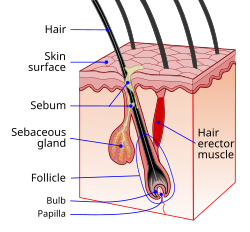Hair follicle
| Hair follicle | |
|---|---|

Hair follicle
|
|

A photograph of hair on a human arm emerging from follicles
|
|
| Details | |
| System | Integumentary system |
| Artery | Supratrochlear, supraorbital, superficial temporal, occipital |
| Vein | Superficial temporal, posterior auricular, occipital |
| Nerve | Supratrochlear, supraorbital, greater occipital, lesser occipital |
| Lymph | Occipital, mastoid |
| Identifiers | |
| Latin | Folliculus pili |
| Code | TH H3.12.00.3.980643 |
| TA | A16.0.00.023 |
| FMA | 70660 |
|
Anatomical terminology
[]
|
|
A hair follicle is a mammalian skin organ that produces hair. Hair production occurs in phases, including growth (anagen), cessation (catagen), and rest (telogen) phases. Stem cells are responsible for hair production. The shape of the hair follicle has an effect on the hair shape and texture of the individual's hair.
The papilla is a large structure at the base of the hair follicle. The papilla is made up mainly of connective tissue and a capillary loop. Cell division in the papilla is either rare or non-existent.
Around the papilla is the hair matrix.
The root sheath is composed of an external and internal root sheath. The external root sheath appears empty with cuboid cells when stained with H&E stain. The internal root sheath is composed of three layers, Henle's layer, Huxley's layer, and an internal cuticle that is continuous with the outermost layer of the hair fiber.
The bulge is located in the outer root sheath at the insertion point of the arrector pili muscle. It houses several types of stem cells, which supply the entire hair follicle with new cells, and take part in healing the epidermis after a wound. Stem cells express the marker LGR5+ in vivo.
Other structures associated with the hair follicle include the cup in which the follicle grows known as the infundibulum, the arrector pili muscles, the sebaceous glands, and the apocrine sweat glands. Hair follicle receptors sense the position of the hair.
Attached to the follicle is a tiny bundle of muscle fiber called the arrector pili. This muscle is responsible for causing the follicle lissis to become more perpendicular to the surface of the skin, and causing the follicle to protrude slightly above the surrounding skin (piloerection) and a pore encased with skin oil. This process results in goose bumps (or goose flesh).
...
Wikipedia
